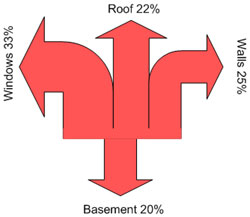The Form Factor – Definition and Importance
The underlying idea here is that, since energy is lost to the environment through the surface of a home, minimizing the surface area will minimize energy losses. The form factor of a home is defined as the surface area divided by the volume:

Typical energy loss distribution of a free-standing single family home (Source: TU Munich)
f = A/V
This equation establishes a non-linear relationship between the shape and size of a structure. The smaller the surface area for a given volume, the smaller the form factor, and the more energy-efficient is the structure. This means that 2- or 3-level houses perform better then single-level structures, such as ranch houses. It also means that simple box-like shapes are better than structures with bump-outs and additions, simply because such features increase the surface area, while not adding much to the volume. Further analysis shows that larger structures, such as high-risers and apartment buildings are the most economical, followed by attached single family homes, town-homes and row houses, while free-standing single-family homes have the largest form factor (typically ranging from 0.8 to 1.2) and are the least desirable. Another reason for avoiding irregular shapes, such as bump-outs, attached family rooms with cathedral ceilings, and bay windows, is the fact that any discontinuities in a wall are likely to have hidden insulation faults, air leaks that greatly reduce the ideal K-value of the insulation material, and ultimately cause much greater energy losses than the higher form factor alone would suggest.




